Art & Exhibitions
‘Curating Is Always About Desire’: Artist Tiona Nekkia McClodden on Her Exhibition Paying Homage to Revered Queer Filmmaker Barbara Hammer
How a 1972 Motorcycle became the conceptual heart of the new show at Company Gallery.
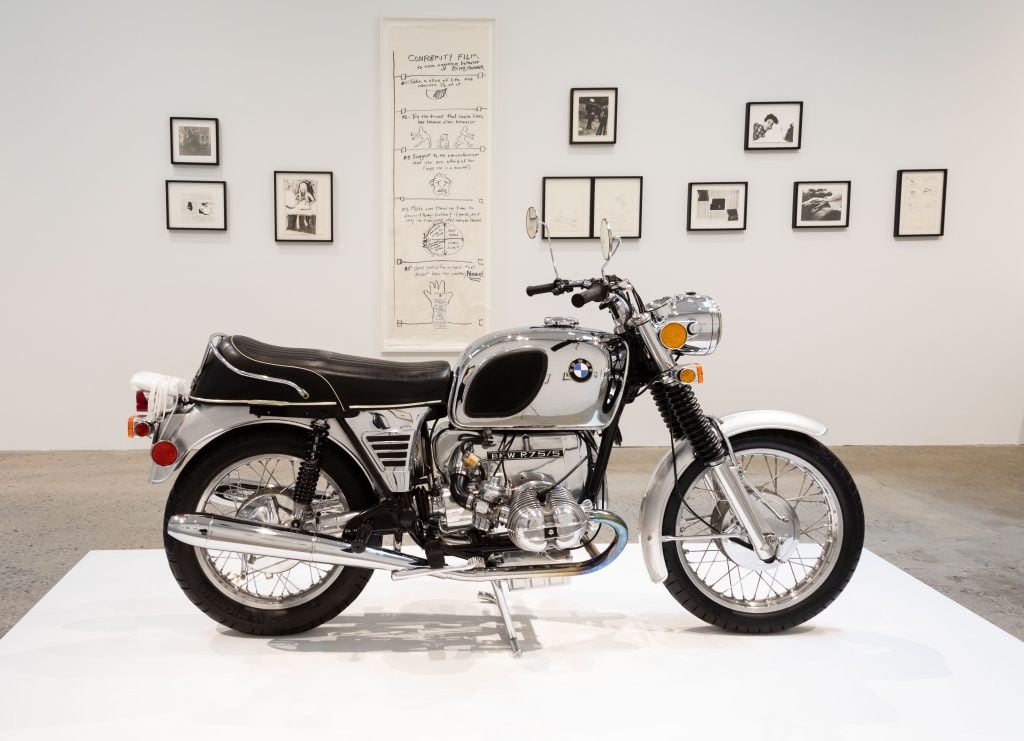
How a 1972 Motorcycle became the conceptual heart of the new show at Company Gallery.

For the inaugural show at its new space, Company Gallery has mounted the first solo show in New York dedicated to the feminist filmmaker Barbara Hammer since her death in 2019. Titled “Tell me there is a lesbian forever…”, the show is curated by artist and filmmaker Tiona Nekkia McClodden, who delved deep into Hammer’s archive to gather videos, photos, and drawings from the first few decades of her practice starting in the late 1960s, when she came out as a lesbian, rode off on a motorcycle with a Super-8 camera, and started creating her experimental films, such as Dyketactics in 1974.
The exhibition, which also features a range of material from Hammer’s papers—love letters, diaristic poems, and her copy of an FBI report on mid-century lesbian rights group the Daughters of Bilitis—performs the labor of building queer community, forging affective bonds across time and across generations. McClodden’s insightful presentation of Hammer’s early work looks at a much beloved figure from new angles, insisting on its relevance for younger queer people.
Recently, we spoke to McClodden about Hammer’s 1972 BMW motorcycle, queer biography, and curating as a practice driven by desire.
The sole artwork of yours in the show is a 1972 BMW motorcycle that you had restored—the same model that Barbara drove in the 1970s. It seems this piece is the conceptual heart of the exhibition and speaks to so many of the themes that you’ve drawn out in Barbara’s work: biography, memory, sensuality, romanticism. How does the motorcycle reflect your own relationship with Barbara, both as a person and as an artist of an earlier generation?
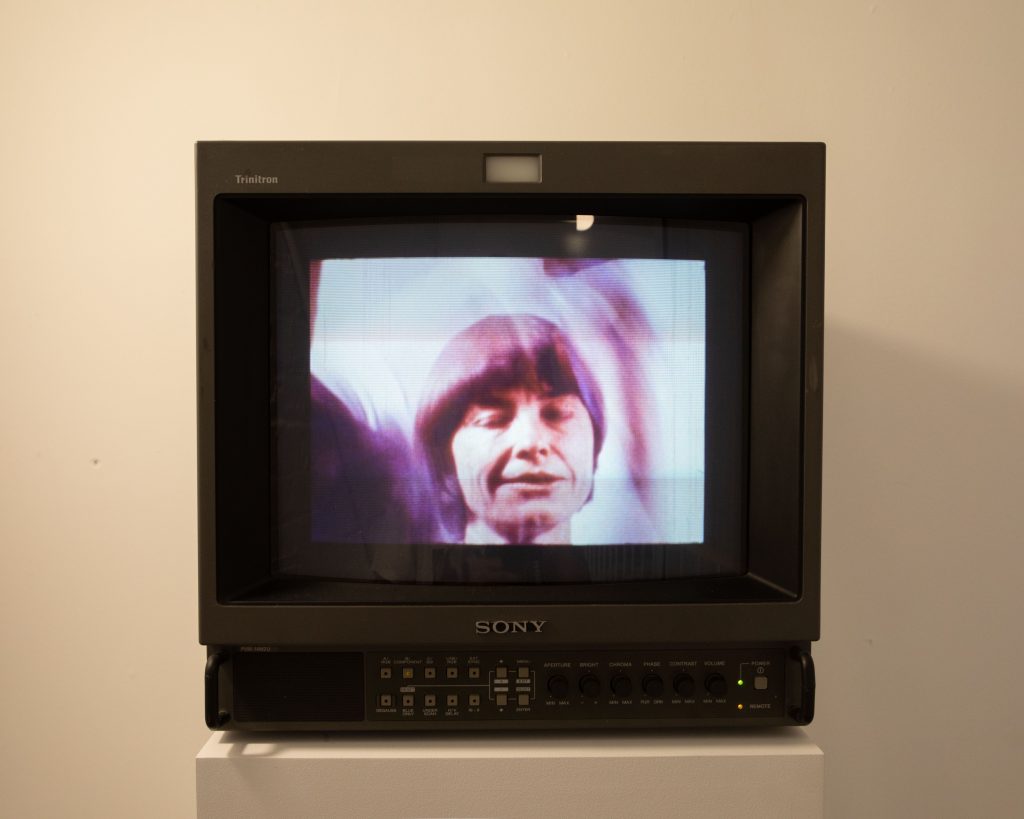
Barbara Hammer, Haircut (1985) still. Courtesy of the artist and Company Gallery.
It’s really cool to be able to talk about this, because I don’t think people understand that Barbara and I didn’t have a long relationship. The first time I ever met her was in 2018, and by that time she was dying. Before that, going all the way back to 2002 in Atlanta when I was trying to be a filmmaker, I knew her work.
I would go to Outwrite Bookstore, the LGBT coffee shop, and they had a section of lesbian magazines—Diva, Girlfriend. These magazines were how I knew that there were lesbian filmmakers at all and there were only a couple of filmmakers included like Barbara, Cheryl Dunye, Michelle Parkerson. But Barbara was special because she was experimental.
When I was working on the show, the first thing that came to me was the bike. There was always one image of Barbara that stuck with me—a photo of her on the road in Baja, California where she’s wearing leather on that bike. I wanted the bike to kind of be this accountability partner, because it felt like something that was an extension of Barbara’s physical being, it had such an intimate interaction with her body. I decided to foreground this thing that is very physical, very sexy. I decided that I wanted it to be this mirror and to be reflective, something that would always catch what was around it.
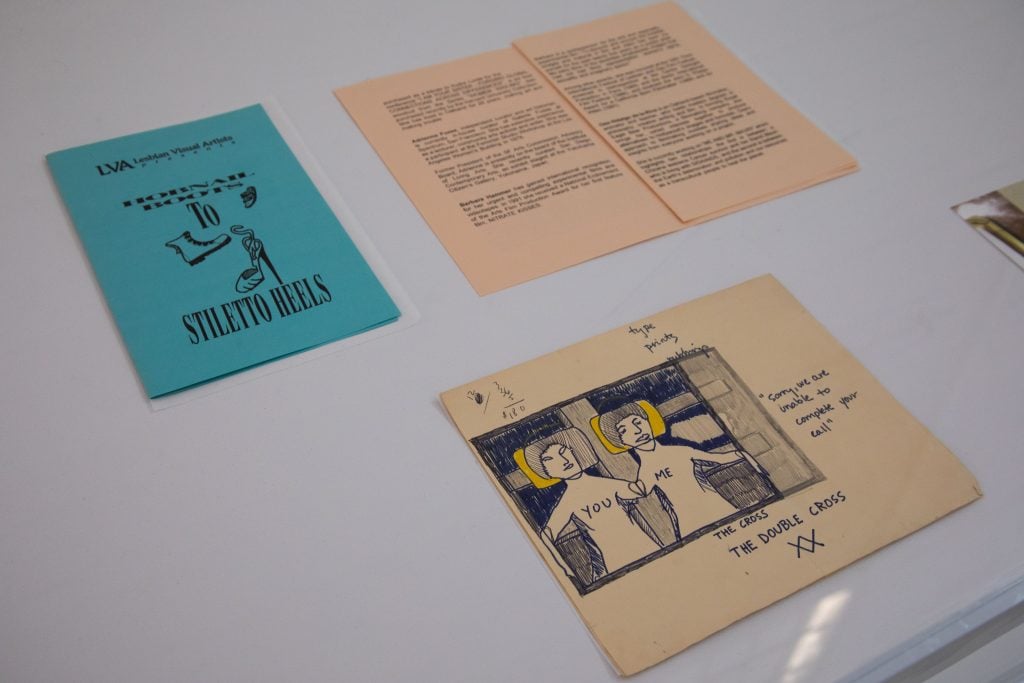
Installation view, “Barbara Hammer: Tell me there is a lesbian forever…” Courtesy of Company Gallery.
I see a real insistence on queer biography with the materials you’ve included—not in the traditional sense of lionizing the artist, but giving a sense of the intertwining of social circumstances, sexuality, and artistic practice. The earliest works you include are from the year that Barbara left her husband and came into her own as a lesbian, taking a motorcycle across the country. How did you seek to present her biography through these objects?
Using the archival materials, I wanted to go into her head. I thought that was a good way to counter the hyper-sexualized narrative around her work. I selected these things that were actually very difficult texts. She’s dealing with her coming out but there’s also these repetitive, manifesto-type poems where she’s stating: “This is what I want, this is what I want, this is what I want.”
In these texts from her archive, she works out a lot of her anxieties around being perceived as this deviant type of person. And I felt very comfortable to include these personal, diaristic texts because Barbara was the one who prepared her archive before it was sent to the Beinecke Library at Yale.
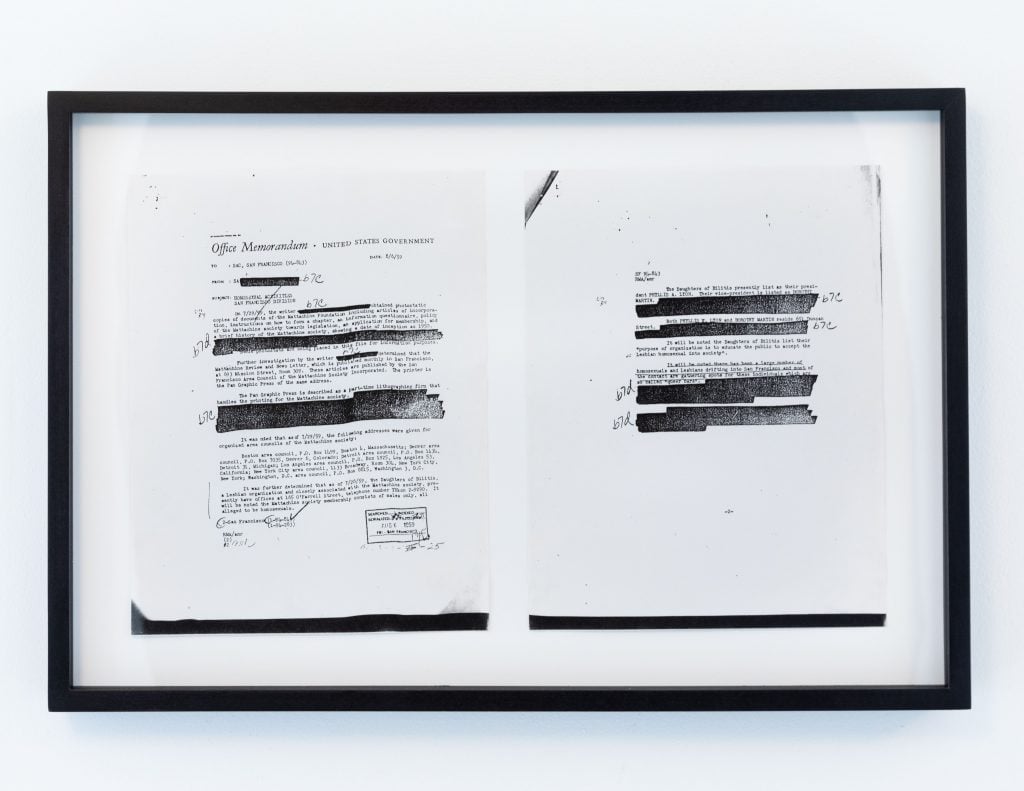
Barbara Hammer, FBI Report, Daughters of Bilitis (1985). Courtesy of the artist and Company Gallery.
One of the things that I love is the way you’ve insisted on blurring the line between “art” and “ephemera” or between gallery and archive. For example, you’ve framed a copy that Barbara owned of the FBI report on the Daughters of Bilitis, or one of her transparencies. It seems you’re asking the viewer to really think hard about what is a work versus what isn’t. What was behind your decision to do this?
It comes from my own practice of looking at ideas around biomythography and rememory. As I was curating the show, I still wanted to hold true to my own interests. Here I am, this Black dyke, looking at this very white woman, so there has to be somewhere where I process this through my subjectivity and the things that I know that allow for a different read of a person.
With Barbara’s show, I really wanted to deal with blurring the line between archive and art, because a lot of her practice deals with issues around documentary. There’s sometimes more fiction in it than people would believe.
When it came to the Daughters of Bilitis FBI report, specifically, I immediately thought: “This is going in a frame.” Immediately, I thought about it as a work of art. I was thinking of it as part of the mission of her practice. The FBI report was just as real or as fictitious as some of the documentaries that she made.
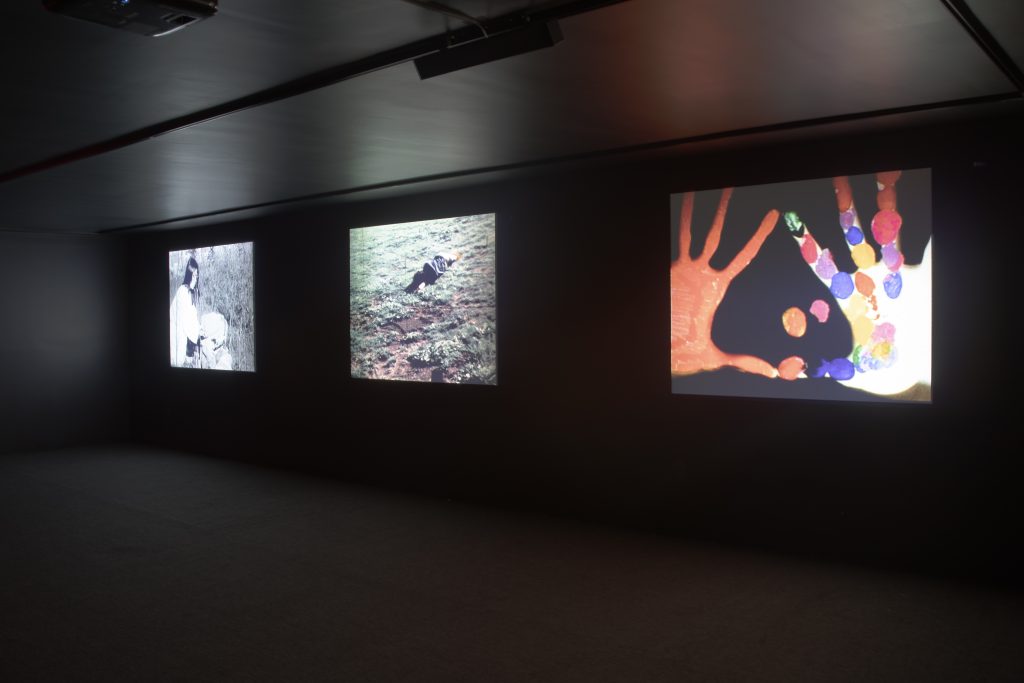
Installation view, “Barbara Hammer: Tell me there is a lesbian forever…” Courtesy of Company Gallery.
In the exhibition text, you talk about Barbara’s love letters reaching you through the person you love. As a PhD candidate at Yale, your partner was able to visit the university library on your behalf when it was closed to the public during COVID. There is a picture in the vitrine downstairs of her hands sorting through the archive. Do you see curating as a labor that is laden with desire, that is defined by affective bonds?
I think, for me, it is because it has to be. I want to make sure that people understand that it’s an artist that’s curating this because curating, quite frankly, is somewhat of a violent position. It’s really about cutting. You could really twist somebody’s shit up. But curating is always about desire. Like when I did the Julius Eastman show at the Kitchen, it was almost to the point of a madness, but that was what that work required—it is obsessive.
Barbara’s work had a more romantic disposition to it. Because of that, I depended on my fiance in a way that I had never before. I could have asked someone else at Yale to visit the archive for me, but I wanted her to do it and I said, “I need you to do it because I love you. It’s about this lesbian identity. I trust what you will find attractive in the archive.”
The second day she went she told me that I should flag this really intense letter to Barbara from this woman named Corky that said, “Tell me there’s a lesbian forever.” She just bust out laughing because the letter was so intense, but I knew in that moment that it had to be the title of the show.
And that photo of her hands in the archive became something that felt very true. That is the affect of this show, that kind of engagement with another woman. She cared for me in real time. That was a moment for me to deal with my love, in this way, where this woman was also dealing with her love in this letter.
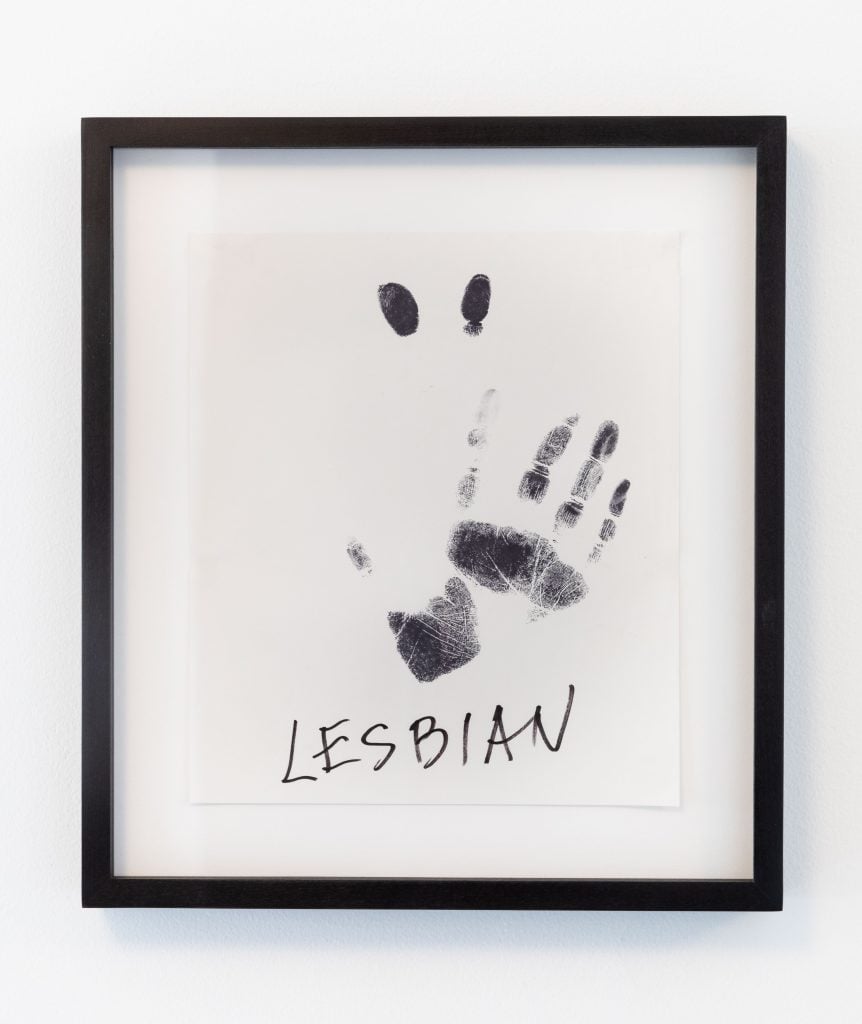
Barbara Hammer,
Hand Print “Lesbian” (1985). Courtesy of the artist and Company Gallery.
How does the show’s title speak to the ways that younger generations of queer people interpret, embrace, and/or reject elements of earlier communities? Lesbian (as well as dyke) were words so important to Barbara’s practice and the period that she made work in, but they aren’t necessarily favored today. What is your own relationship to these terms?
I’m a Black dyke. It’s a word that I’ve always returned to. I think that one of the things that Barbara and I have in common is that there have been some complicated situations in our respective lives and practices where there has been this forced antiquation of the idea of lesbian or dyke. I find that to be dangerous because it’s an identity that is always evolving. So my thing with the show was to show Barbara to be this woman who was constantly interrogating her identity.
I wanted the show to attract an intergenerational crowd. There are older lesbians who have felt like they can’t come into certain spaces because they’ll be seen as antiquated by younger folks. Because I’m 40—I’m not too old yet and I’m also not that young—I felt like I could do this middle ground thing where there’s a place for everybody. And that revealed itself at the opening because so many people came from all over the spectrum of identity, age, everything.
My goal has always been to figure out how to bridge the past with the present and show that it’s not a looking back, looking forward thing. It’s more looking side to side—and that’s really what this was about for me.